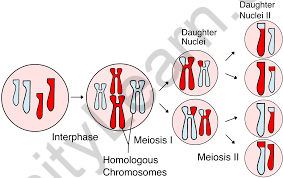Table of Contents

Introduction
Meiosis – It is a type of cell division in which sexual reproduction produces gametes such as sperm and egg cells. It also has two phases that lead to the formation of four female cells. In this type of division, the number of chromosomes is halved and produces four gamete cells.
This division of cells occurs in the diploid parent cells that indicate that it contains two female cells. In the case of diploid parents, they make the replication of one DNA and two types of meiosis cell division namely meiosis 1 and meiosis 2. These two meiotic phases lead to the formation of four haploid girl cells that contain part of -p dip parentid parent chromosome. Cell.
Stages of meiosis
In many ways, meiosis is similar to mitosis. The cell goes through the same stages and uses the same techniques to organise and divide chromosomes. In meiosis, however, the cell has a complex function. It still needs to separate the sister chromatids (two halves of a double chromosome), as in mitosis. But it should also differentiate homologous chromosomes, pairs of the same chromosome but not the same thing the body received from its two parents.
These goals are achieved in meiosis using a two-step separation process. The homologue pearls split between the first round of cell division, called meiosis I. The sister chromatids split in the second round, called meiosis II.
Since cell division occurs twice during meiosis, the first single cell can produce four gametees (eggs or sperm). In each division cycle, the cells go through four stages: prophase, metaphase, anaphase, and telophase.
Meiosis I
Prior to meiosis, during the S-phase of the cell cycle, the chromosome of each chromosome is multiplied to acquire two identical chromatid sisters and these are bound together by sister chromatid interactions. This is about the premeiotic S phase or also called the meiotic S-phase.
After DNA replication, meiotic cells enter a G2-like phase called meiotic prophase where homologous chromosomes pair and genetic reunification occurs. A structured process by which DNA can be cut and rearranged allows them to exchange genetic information. Crossing over occurs through a subset of recombination events that results in the creation of visible connections called chiasmata between homologous chromosomes.
In many organisms, chiasmata helps direct each pair of homologous chromosomes to separate or divide between Meiosis I. It results in the creation of two haploid cells that form part of the number of chromosomes resembling the parent cell.
Meiosis II
During this process, a fusion between the sister chromatids is released and separates one from another (similar during mitosis). In some cases, all four meiotic products form gases that include sperm, pollen, or grains. Females have 3 out of 4 meiotic products that are released from the body and eventually, only one cell emerges to produce an egg. Given that the number of chromosomes decreases by half during meiosis, the gamete now fertilizes and forms the diploid zygote consisting of two copies of each chromosome, one for each parent.
Thus, the rotating cycles of meiosis and fertilization enable reproduction and each successive generation maintains the same number of chromosomes. For example, diploid human cells have 23 pairs of chromosomes comprising 46 pairs of sex chromosomes i.e. a total of 46 and a half originating from the mother side and the other half from the father side.
Meiosis produces haploid gametes ova / sperm where each contains one set of twenty-three chromosomes. When two gametes, an egg and sperm mating occur, the built-in zygote becomes a diploid when the mother and father donate 23 chromosomes each. The same pattern (except for the same number of chromosomes) occurs in all organisms using the meiosis process.
Meiosis occurs in all cellular and single-celled organisms and all eukaryotes include plants, animals and fungi. It is an important mechanism needed for spermatogenesis and oogenesis.
How Is Meiosis Different From Mitosis?
Although in both mitosis and meiosis, the process of general cell division is related, yet it differs from two major factors including:
Regeneration:
Meiosis creates a genetic mix between two chromosomes in each pair that are inherited from each parent. It leads to the creation of regenerated chromosomes into a unique genetic component for all gamete. On the other hand, mitosis occurs only when it needs to repair DNA damage and usually occurs among the same chromatid sisters and does not cause genetic mutations.
Chromosome Number:
Meiosis produces 4 different genetic cells with a fraction of the number of chromosomes as in the parent cell. On the other hand, mitosis produces two identical gene cells and each has the same number of chromosomes as the parent cell.
FAQs
Q1. Explain what two reasons we get genetically differentiated genes for meiosis classification?
Answers. It is the site where homologous chromosome abruption occurs and genetic mutation occurs randomly and this process is different for each cell that passes through meiosis.
Random layout of homologous pairs: In metaphase 1, a random shape of homologous pairs occurs. With this, production of gametes with a wide variety of homologous chromosomes occurs.
Q2. Why is meiosis I different from Meiosis II?
Answers. In the case of meiosis I, a breakdown of the homologous chromosome occurs and in the case of meiosis II occurs the separation of the sister chromatids.
In meiosis I two daughter cells are formed and, in meiosis II, four female cells are formed.
Also Check For
MCQs on Meiosis – Introduction and MCQs
Differences between Mitosis and Meiosis







